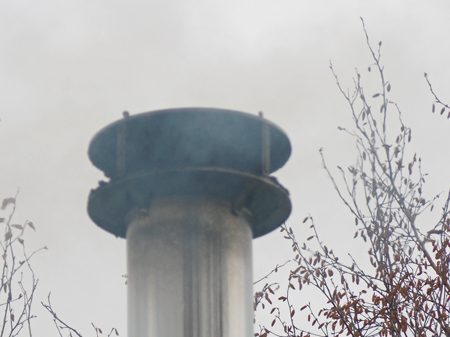
Technology that removes fine particulates from wood and coal stove smoke is being readied for testing in North Pole as part of a citizen science project.
Local veterinarian Jeanne Olson and a group of other Citizens For Clean air members installed the electrostatic precipitator device in the woodstove pipe at her clinic last week, and Olson said it’s awaiting final check.
“To make sure it’s centered right and isn’t going to arc. I haven’t lit the fire in my stove to check that, but I’m planning to do that this week,” Olson said. “We’re looking to get some instruments to test the emissions, all different conditions this winter.”
Olson received the $2,000 Swiss-made unit, called an EcoTube, from company representative Nico Lauer.
Lauer travelled to Fairbanks last week to deliver and help install the stack mounted device, which creates a low power electric field inside the stove pipe.
“This electric field basically ionizes the particles that go through it,” Lauer said. “They get charged electrically, and because of the electric charge, it gets attracted to the chimney and deposits there — takes up all of the fine dust out of the smoke.”
Electrostatic precipitator technology has a long history of use in power plants and other industrial applications.
The EcoTube residential-sized unit has been available for six years, but only available in the U.S. since September.
Lauer said only two others have been installed in the U.S., but thousands are in use in several countries, and it should work here too.
”We have no doubts whatsoever that’s going to function right away,” Lauer said. “My recommendation is that you do, probably a season’s worth of testing to get the insurance that this thing operates well.
North Star Borough Air Quality Control commission vice chair Cathy Cahill has a Ph.D. in atmospheric science with three decades experience studying air pollution.
“We don’t have the information necessary to really evaluate its functioning under our conditions,” Cahill said.
Cahill said proving the effectiveness of the Eco Tube will require thorough local testing.
“Yes, they’ve used it other places in the world, but they don’t have a long track record of working with the kinds of fuels we work with,” Cahill said. “I’m definitely interested in seeing how this is actually going to function.”
Cahill applauded the citizen science project that Olson and Citizens for Clean Air have undertaken in North Pole.
She said the borough does not have the capacity to test the Eco-Tube.
“At the moment, having people watch whats happening at Jeanne Olson’s house in terms of how the ESP works,” Cahill said. “It’s going to be a key first step, and then we can try to see if we can apply for grants for pilot projects.”
EcoTube’s Lauer said the company already has gotten the units certified in other countries, and is willing to go through the process to get U.S. approval.
”If there’s issues about certification by the EPA, we’ll be delighted to do it,” Lauer said. “Needless to say, it’s approved around the other countries of the world where people are using it.”
The technology was brought to local attention by borough assembly member Lance Roberts, who’s sponsored an ordinance to allow people who install the devices on their stove pipes to be able to operate them during local burn bans triggered by poor air quality.
The measure, which is pending before the assembly, would also allow qualifying residents to be reimbursed the cost of the device through a borough subsidized program.
